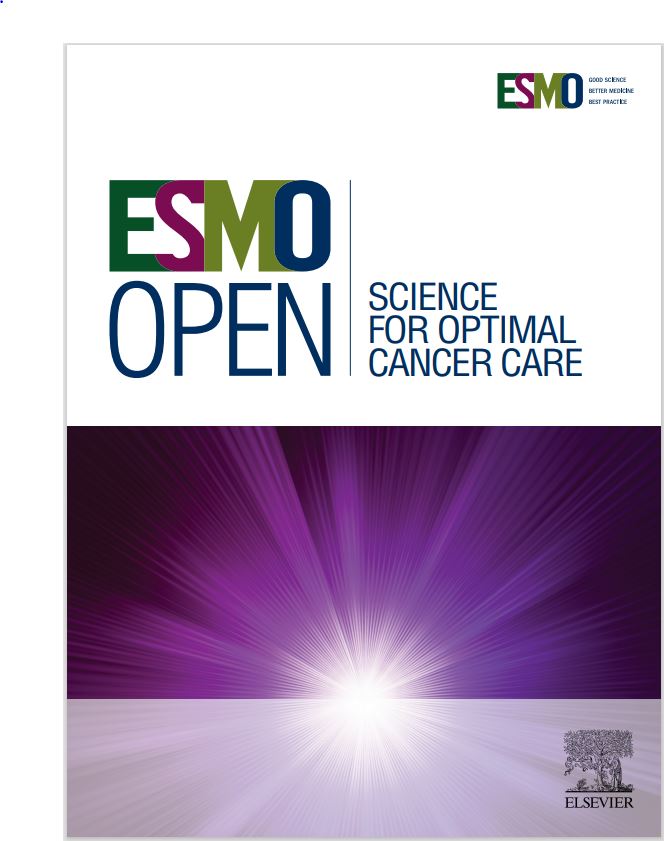Refining prognostic tools for luminal breast cancer: genetic insights and comprehensive analysis
IF 7.1
2区 医学
Q1 ONCOLOGY
引用次数: 0
Abstract
Background
Luminal breast cancer (BC) is generally associated with a lower risk of recurrence compared with other subtypes. However, patients with luminal BC can still experience recurrence, which remains a significant concern and contributes to BC-related mortality. Current clinical practice for recurrence risk prognosis relies on prognostic tests based on tumor gene expression profiles.
Materials and methods
In this study, we aimed to investigate the association between different genetic alterations with the likelihood of recurrence and gene expression prognostic prediction (Oncotype DX®, MammaPrint®, and PAM50-ROR) in luminal BC patients. We constructed three transcriptome-based predictive models, based on these widely used clinical tests, to evaluate the recurrence risk of patients with luminal BC, using RNA-seq data from 1527 samples across 11 datasets. We further classified 1780 patients from the TCGA and METABRIC datasets into risk groups and detected distinct recurrence risk patterns.
Results
Our analysis revealed that low-risk groups had higher frequencies of mutations in PIK3CA, MAP3K1, CDH1, KMT2C, and CBFB, as well as co-mutations in PIK3CA-MAP3K1, PIK3CA-CBFB, and KMT2C-MAP3K1. In contrast, high-risk groups showed enrichment of TP53, RB1, and PTPN22 mutations compared with the whole cohort, with notable co-mutations in TP53-PIK3CA and TP53-KMT2C. Furthermore, mutations in TP53 and BRCA2, and deletions in the 7p22.3 region were at least threefold more frequent in high-risk patients compared with low-risk patients. Using an independent dataset, we validated our finding of higher frequency of BRCA2 mutations in Oncotype DX® high-risk patients. Notably, PIK3CA mutations had an unexpected negative impact on recurrence and survival among high-risk patients.
Conclusion
Our study reveals key genetic factors associated with recurrence risk in luminal BC. Identifying these mutations and copy number alterations provides a basis for refined prognostic models and suggests avenues for further research, potentially improving treatment strategies and follow-up care for patients with luminal BC.
改进腔内乳腺癌的预后工具:遗传见解和综合分析
背景:与其他亚型相比,腔内乳腺癌(BC)通常具有较低的复发风险。然而,腔内BC患者仍然可能出现复发,这仍然是一个值得关注的问题,并导致BC相关的死亡率。目前的临床实践对复发风险预后依赖于基于肿瘤基因表达谱的预后测试。材料和方法在本研究中,我们旨在研究腔内BC患者不同基因改变与复发可能性和基因表达预后预测(Oncotype DX®、MammaPrint®和PAM50-ROR)之间的关系。基于这些广泛使用的临床试验,我们构建了三个基于转录组的预测模型,使用来自11个数据集的1527个样本的RNA-seq数据来评估腔内BC患者的复发风险。我们进一步将来自TCGA和METABRIC数据集的1780例患者分为不同的风险组,并检测到不同的复发风险模式。结果低危组PIK3CA、MAP3K1、CDH1、KMT2C和CBFB突变频率较高,以及PIK3CA-MAP3K1、PIK3CA-CBFB和KMT2C-MAP3K1共突变频率较高。与整个队列相比,高危组TP53、RB1和PTPN22突变富集,TP53- pik3ca和TP53- kmt2c共突变显著。此外,TP53和BRCA2突变以及7p22.3区域缺失在高危患者中的发生频率至少是低危患者的三倍。使用一个独立的数据集,我们验证了我们在Oncotype DX®高危患者中BRCA2突变频率更高的发现。值得注意的是,PIK3CA突变对高危患者的复发和生存产生了意想不到的负面影响。结论本研究揭示了与腔内BC复发风险相关的关键遗传因素。识别这些突变和拷贝数改变为完善预后模型提供了基础,并为进一步研究提供了途径,有可能改善管腔BC患者的治疗策略和随访护理。
本文章由计算机程序翻译,如有差异,请以英文原文为准。
求助全文
约1分钟内获得全文
求助全文
来源期刊

ESMO Open
Medicine-Oncology
CiteScore
11.70
自引率
2.70%
发文量
255
审稿时长
10 weeks
期刊介绍:
ESMO Open is the online-only, open access journal of the European Society for Medical Oncology (ESMO). It is a peer-reviewed publication dedicated to sharing high-quality medical research and educational materials from various fields of oncology. The journal specifically focuses on showcasing innovative clinical and translational cancer research.
ESMO Open aims to publish a wide range of research articles covering all aspects of oncology, including experimental studies, translational research, diagnostic advancements, and therapeutic approaches. The content of the journal includes original research articles, insightful reviews, thought-provoking editorials, and correspondence. Moreover, the journal warmly welcomes the submission of phase I trials and meta-analyses. It also showcases reviews from significant ESMO conferences and meetings, as well as publishes important position statements on behalf of ESMO.
Overall, ESMO Open offers a platform for scientists, clinicians, and researchers in the field of oncology to share their valuable insights and contribute to advancing the understanding and treatment of cancer. The journal serves as a source of up-to-date information and fosters collaboration within the oncology community.
 求助内容:
求助内容: 应助结果提醒方式:
应助结果提醒方式:


